
The Ultimate Mezcal Guide: Everything You Need to Know!
WELCOME TO MEZCAL
If you've already familiarized yourself with tequila — in terms of collecting knowledge about the spirit, not just pounding shots of the stuff while you speak Spanglish — then it's time to add its smoky cousin, mezcal, to your repertoire of base ingredients that work great in sexy Mexican cocktails. And while mezcal is generally less popular than tequila, at least in the U.S., it does seem to be on the rise thanks to bartenders and mixologists experimenting with it in a whole range of mixed drinks, as well as its competence as a little sipper served neat. Considering this rise in popularity, as well as mezcal's unique flavor profile, it makes sense that you'd want to do lots of experimentation with it at home with your friends and family, right? https://giphy.com/embed/3o6wrjHZkRiIXQFlgQ But before you go about messing around with this fine agave-based liquor, you'll want to know all about it so you can impress everybody with your esoteric understanding of where mezcal comes from, and y'know, what it is exactly. With that reasoning in mind, let's take a deep (yet brief) dive into mezcal and learn about its history, how its made, and how exactly how it should be used in all of your own unique mixed drink creations. So sit back, grab a nice copita full of reposado mezcal, and enjoy wandering your way through this Ultimate Mezcal Guide. https://giphy.com/embed/3o6wroAy3HODh3Hh5eWHAT IS MEZCAL
Alright, so first things first: What the heck is mezcal, exactly? Just a redheaded stepchild of tequila, right? No! Absolutely not! In fact — and this will really blow your noggin wide open if this is news to you — tequila is a type of mezcal. That's right, mezcal is tequila's daddy. OK, that's a weird way of putting it, but still, if you were to put together a hierarchy infographic of agave spirits, tequila would go underneath mezcal as a subcategory. In terms of its actual definition, Wikipedia simply defines mezcal as "a distilled alcoholic beverage made from any type of agave." This isn't the whole story, however, as there are other restrictions in place that define a mezcal. For example, mezcal can only be made in certain parts of Mexico; it also must now be made with 100% agave in all instances. Other than that, there aren't many major restrictions that define a mezcal that you'll need to know about off the cuff. There are certainly other regulations that are enforced by Norma Oficial Mexicana (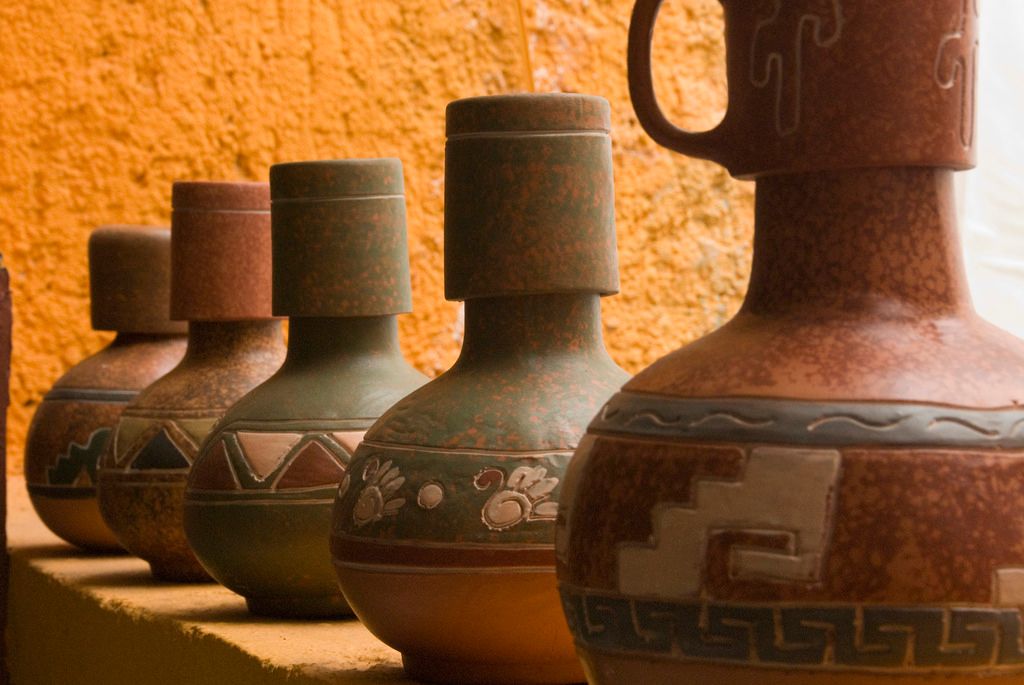
Mezcal stored in clay pots. Image: Flickr / gen gibler
As far as the broad strokes of mezcal's history, the basics you'll want to know about if it comes up in casual conversation is that it dates back more than 400 years to when conquistadors from Spain first invaded what is now Mexico. As the (hotly debated) story goes, the conquistadors loved getting tipsy on their own brandy brought over from Spain, but once they ran out of it, they looked to distilling pulque beer into a higher ABV beverage. That new, distilled beverage was dubbed mezcal, which comes from the Nahuatl word mexcalli, and literally translates to “oven-cooked agave.” (We'll get much deeper into mezcal's history below.)
Conquistadors with natives. Image: Wikimedia / Pedro Lira
Other than that, if somebody catches you at the bar or in your living room and wants to squeeze some quick, pertinent mezcal information out of you, just know that it's apparently becoming a lot more popular. Or at least a lot more popular than it once was. As Shaken News Daily noted in a 2018 article titled Mezcal Rides A Surge Of Popularity In The U.S., "Though it remains a small player within the overall spirits universe, mezcal is enjoying a major boost in popularity, especially in the United States. Total U.S. volume is still tiny at under 400,000 cases—or about 2% the size of the Tequila category—but rapid expansion is underway, with shipments roughly quadrupling over the past half-decade." Future Market Insights also notes that "the global demand for Mezcal will soar vigorously in the next five years," and that "By the end of 2022, over US$ 840 [million] worth of Mezcal is anticipated to be consumed across the globe." As with everything else mentioned in this section though, we'll get more into this below. https://giphy.com/embed/1gQXx8aEpAUkbnp4dX So with all those broad strokes in mind, let's begin our deep dive and start out with an overview of mezcal's history!A BRIEF RECAP OF MEZCAL'S ORIGINS
As always, we won't be going too crazily deep into this spirit's history, but if you have what's written here committed to memory, we promise you'll be able to impress just about anybody with your mezcal knowledge. Because there's so much history to cover with mezcal if you really wanted to get into it, and because we have limited real estate here, we'll just be focusing on where mezcal comes from.THE CONQUISTADORS INVADE AND MEZCAL IS BORN
As mentioned above, mezcal's origins can be traced to the conquistadors invading what is now Mexico in the 16th century. Why and how did this happen exactly? That has something to do with a drink called pulque and the conquistadors' quest not only for gold, but also for something a lot more potent than pulque. If you're wondering what pulque is, and you probably are, it's essentially the most basic, lowest ABV alcoholic beverage you can make from an agave plant. But even at 4-8% ABV, it was considered to be pretty dang magical by ancient peoples who first created/discovered it nearly 2,000 years ago.
A bottle of unflavored pulque beer. Image: Wikimedia / AlejandroLinaresGarcia
Despite pulque being a fine boozy beverage for the peoples inhabiting what is now Mexico for over 1.5 millennia, however, it wasn't nearly good enough for the Spanish conquistadors, who were used to distilled wine, a.k.a. brandy, which had a much higher ABV percentage than pulque (think something on the order of at least 35%). So, lacking any wine or fruit juice to ferment, the Spaniards took the pulque and distilled it, thus creating the very first mezcals. A key point to note with this first distillation of agave-derived alcohol however — why it was really only mezcal and not tequila created at this point — is how exactly the agave piñas were “oven cooked.” (Piña being the name for the heart of the agave plant after its leaves have been sheered off, because it looks like a pineapple.) In the 16th century, and up until today, in fact, mezcals (at least most of them, there are exceptions) were and are cooked using underground, earthen pits. To sum up mezcal's birth: It happened when conquistadors came to mesoamerica in the 16th century, ran out of rum, and decided to distill the alcoholic drink, pulque, into a much higher ABV drink.MEZCAL VS. TEQUILA (‘CAUSE IT’S GOING TO COME UP)
When it comes to mezcal vs. tequila, what you’ll hear over and over again is this: All tequilas are mezcals, but not all mezcals are tequilas. Which is technically true because mezcal is any “distilled alcoholic beverage made from any type of agave plant native to Mexico,” and tequila is most definitely a distilled alcoholic beverage made from an agave plant in Mexico. So before we clarify the difference between the two, keep in mind that tequila is a type of mezcal. https://giphy.com/embed/noSuUxl9oJZ5uAs far as how to the two are different, that comes down to these three core points:
1. Mezcal and tequila are produced in different states in Mexico. Tequila is mainly produced in Jalisco, while mezcal is mainly produced in Oaxaca. Keep in mind, however, that both spirits are also produced in (very limited) respective surrounding regions, and that some regions produce both tequila and mezcal. 2. Tequila, by law, can only be made with the blue agave plant. Mezcal on the other hand, can be made with more than 30 different types of agave plant, although the majority are made with Agave Espadin. 3. Although both Tequila and mezcal are produced from agave plants, their differing production methods cause changes in flavor. For example, it’s common for mezcals to have a smoky flavor due to their unique roasting process. Some also note that Mezcals tend to taste sweeter and richer than tequila. So if you’re at the bar and you want to pop off with a display of overarching agave-spirit knowledge, those are basically the points you need to know.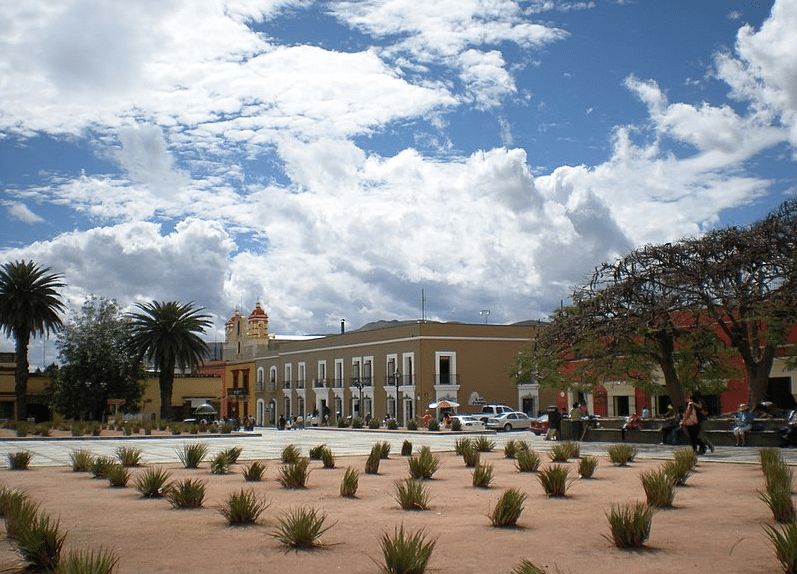
The Oaxaca region of Mexico, where most mezcal is made. Image: wikimedia / boskimano
HOW MEZCAL IS MADE
Now that we know what mezcal is, how it was discovered, and how it differs from tequila, let's take a look at how it's actually made. And surprise surprise, its production process is very similar to that of tequila, which is why much of the following explanation has been taken directly from the Ultimate Tequila Guide.1. HARVESTING VARIOUS TYPES OF AGAVE
Unlike tequila, which can only be sourced from the Agave tequilana or the 'Weber Azul' agave plant, mezcal can be made from any type of agave plant except for blue agave. These agave types include everything from Agave americana to Agave karwinskii to Agave rodacantha to Agave potatorum although, as the Mezcal PhD notes, a single type of agave, Agave espadin, accounts for about 90% of production. The plants are harvested by mezcaleros, who are a special type of Mexican farmer and distiller who’s been trained to identify ripe agave perfect for making mezcal. (Keep in mind, as mentioned above, that mezcal agave plants are mainly taken from Oaxaca, a federal state of Mexico. Although they're also pulled from Durango, Guerrero, Guanajuato, Michoacan, Puebla, San Luis Potosi, Tamaulipas, and Zacatecas.)
A jimador (similar to a mezcalero) chopping the leaves from a piña. Image: Flickr / omarsan
The mezcaleros use coa de jima, or “hoes for harvesting,” to cut away the agave plants’ leaves, leaving the heart of the agave plant, the piña, which is then stuck in a truck and sent to be cooked. https://giphy.com/embed/2shPJo68inkbu2. COOKING THE PIÑAS
Now that the piñas have been plucked and had their leaves sheared off, it’s time to do some cookin’! This step occurs in order to catalyze the chemical process within the piña that converts complex carbohydrates into fermentable sugars. Cooking also softens the piñas, which allows said fermentable sugars to be extracted more easily. That’s the explanation of what’s happening with this step into terms of the why. In regards to the how, you more or less have one method for cooking these bad boys: by sticking them in earthen pits that will be heated and covered with dirt. Which sounds kind of dirty, but keep in mind this is the step that imparts mezcal's signature smoky flavor.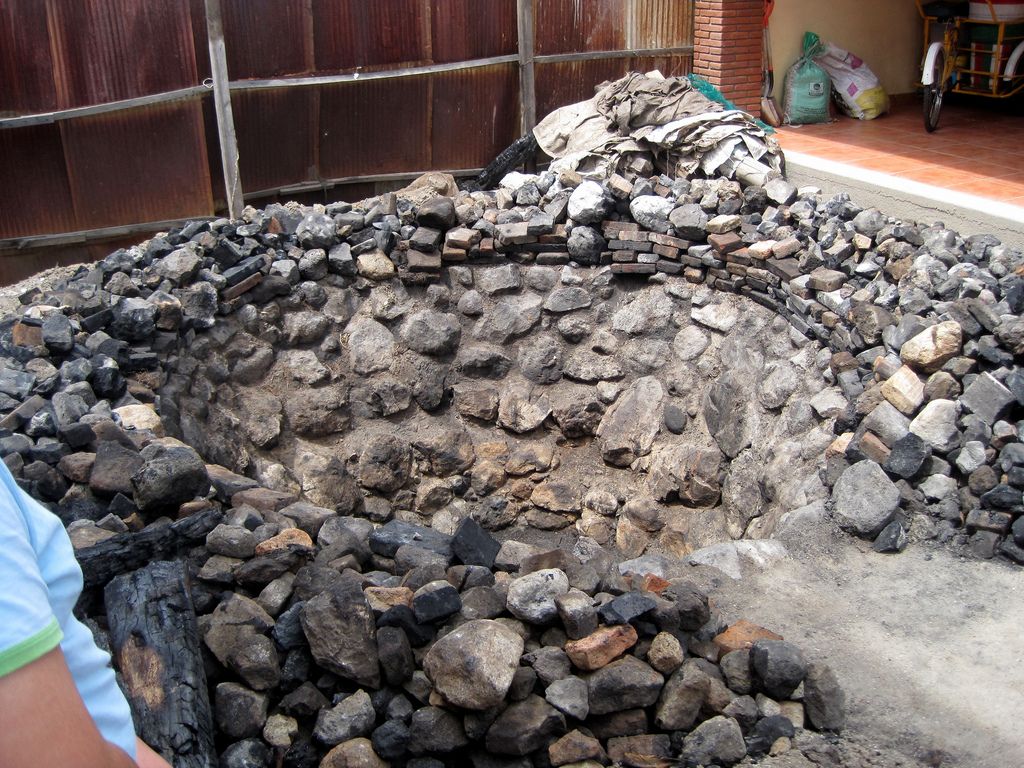
A look at the earthen pit the piñas are cooked in (prior to being set on fire and filled). Image: Flickr / Cleong
To make one of these earthen ovens, all you really need to do is dig a giant pit, get some rocks, and start a fire underneath them; then you throw cut-up piñas on top of the rocks, cover that all up with dirt, and let the piñas roast for about 8-10 days. And then bang, you have yourself an earthen pit perfect for roasting agave hearts.3. CRUSHING THE PIÑAS
Once the piñas have been cooked, they’re taken to a milling area where they’re crushed in order to have their sugary juices, or aguamiel, extracted. This process is executed by sticking the piñas in a pit and then crushing them with a tahona, which is basically a large stone wheel that’s tied to a wooden stake, and rolled around in circles over and over thanks to mule power — seriously, this is some Flinstones kind of stuff. Then, after the piñas are crushed, they’re soaked in water in order to extract the sugars. The mashed piñas are strained out of the sugary juice, and often reused as compost or for animal feed. (Sometimes it’s even burned as fuel or processed into paper.) Note that there's another, even less technologically advanced method for crushing the piñas that calls for sticking them between two pieces of wood and then smashing them mercilessly with a sledgehammer.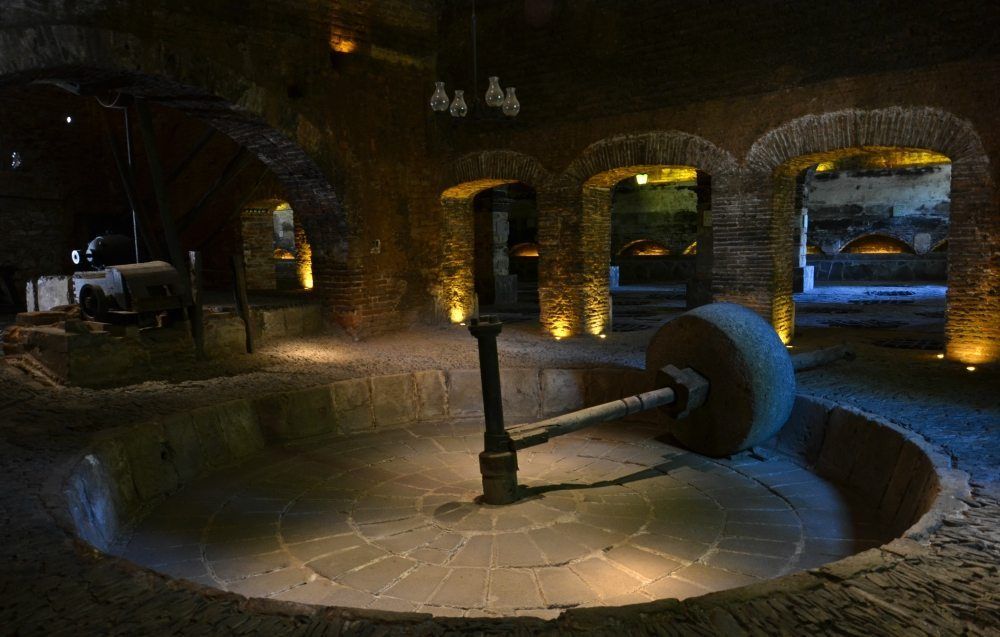
Tahona used for crushing piñas. Image: Flickr / omarsan
4. FERMENTING THE JUICE
Once the aguamiel has been extracted from the cooked, crushed piñas (we only destroy you because we love you, piñas), it’s then time to start fermenting some sugar water in order to create some booze! This happens by taking the aguamiel and dumping it into large fermentation tanks made out of wood. The aguamiel is fermented by adding yeast (a single-celled organism), which takes the fermentable sugars and turns them into ethanol (alcohol that can get you tipsy), CO2, and other byproducts including various molecular flavor compounds. This alcoholic liquid (which is about 4-5% ABV), is called the mash. The below GIF gives a little glimpse at what mezcal fermentation actually looks like. https://giphy.com/embed/39u4aWvuTHAtNdZ5ho5. DISTILLING THE MASH
Once you have your mash, it's time to up that ABV from 4-5% to something around 37.5% by distilling it in either clay or copper stills. But mezcal, like tequila, isn't just distilled once, it's distilled twice. And in certain cases even three times. This is the case because the double or triple distillation ups the ABV even further, and also helps to remove impurities from the mezcal, making it a "cleaner" spirit. In terms of how distillation works, it's more or less the same process that all the other liquors go through, although mezcal stills are often made out of unique materials (such as clay) and aren't nearly as industrialized as those used in other liquor distilleries.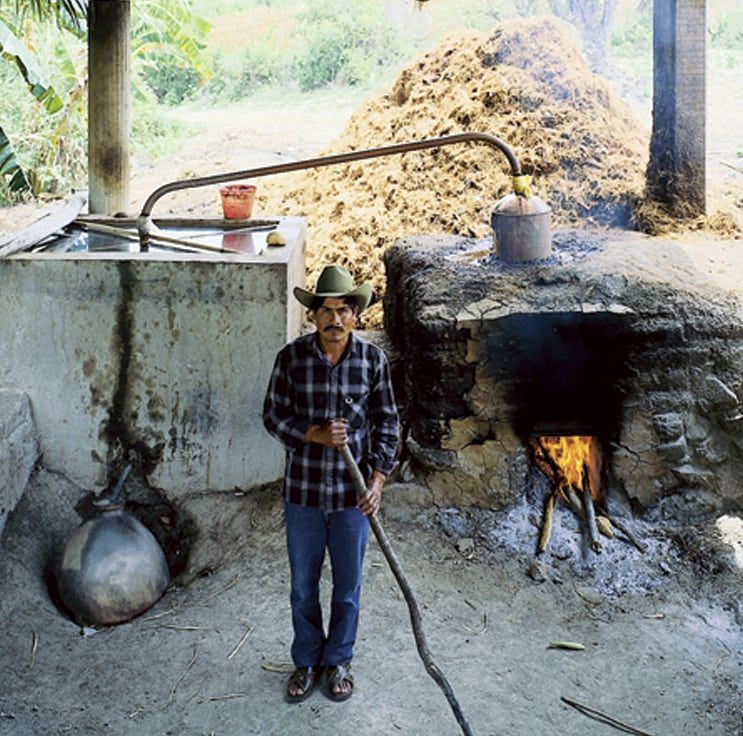
Mezcalero standing in front of a small mezcal still. Image: Wikimedia / Agave
Basically, the fermented mash is placed in copper or clay stills, which have large, voluminous bottoms leading up to narrow, tubular tops. Once the mash has been placed in the stills, a fire's lit beneath them and the heat from the bottom of the stills causes the mash — which is made up of ethanol (C2H6O) and water (H20) — to boil and turn into vapor. But because ethanol has a lower boiling temperature than water, 173.1 degrees Fahrenheit versus 212 degrees Fahrenheit, you’ll have a lot more ethanol vapor firing up the still's narrow tubular top than water. What does this mean? The liquid that comes out of the opening of the long tubular neck at the top is going to be much higher ABV than what you started with, because it has a lot less water in it. Once the mezcal has been distilled — had its ABV upped substantially — it's time to do some barrel aging.6. BARREL AGING THE MEZCAL
Once you have your fermented and distilled liquor made from one or another type of agave (except for blue agave!), then it's time to start barrel aging it. Although it doesn't need to be barrel aged. In fact, mezcal can be bottled right after the distillation process. This type of unaged mezcal is known as joven or blanco. If the goal is to add some of that sweet sweet barrel flavoring to the mezcal however, this is the point at which it would be stuck inside wooden casks and left to age for anywhere from a few months to 12 years. As far as barrel aging is concerned, almost every barrel is a French or American white oak barrel that has previously been used to age Bourbon.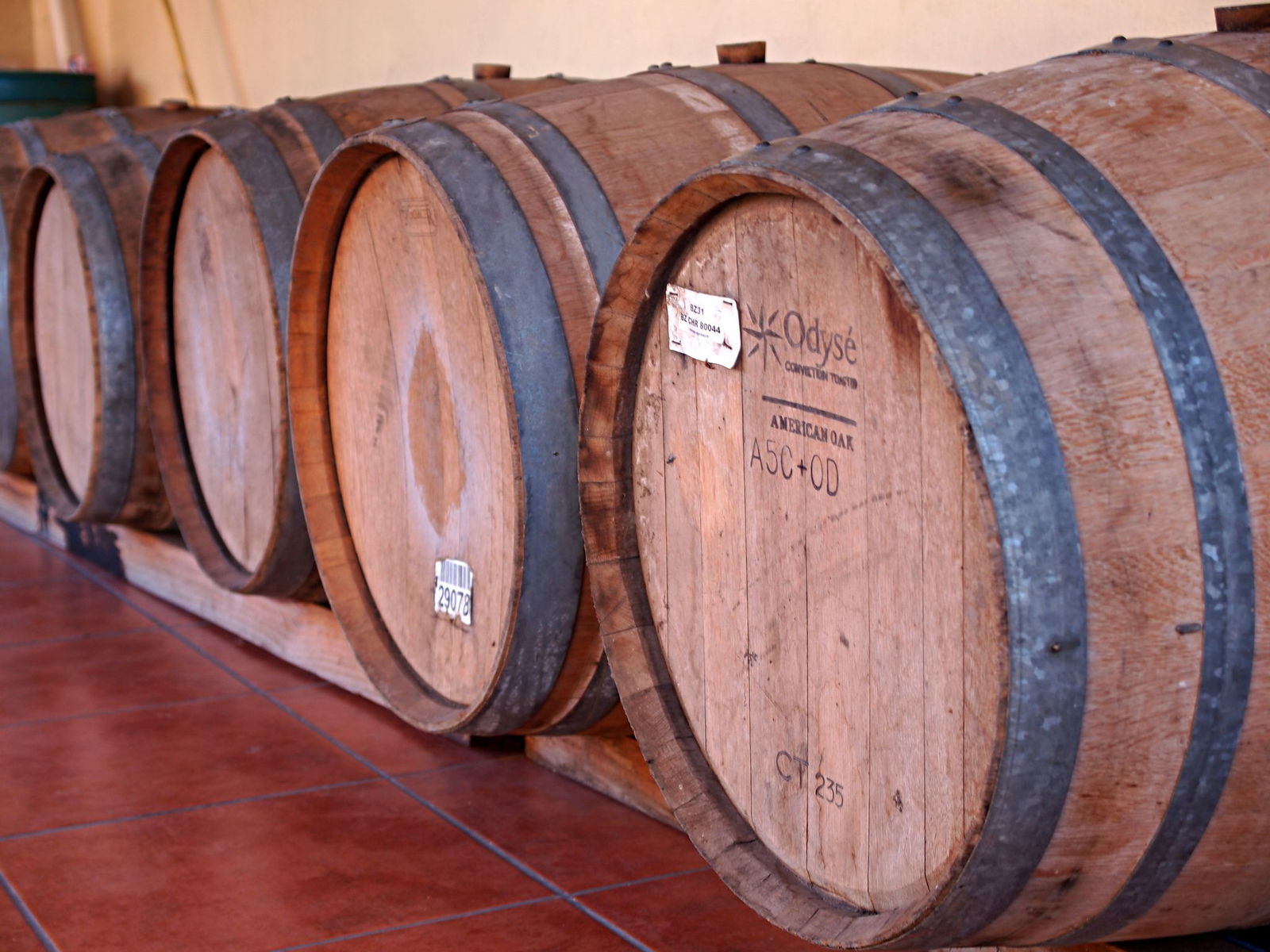
Barrels for aging mezcal. Image: Flickr / Dainis Matisons
Keep in mind that it is the barrel aging process that changes the color of mezcal — when any type of mezcal first comes out of the stills, it’s clear. Most of the time, the longer a mezcal ages, the more amber color it will take on, as well as barrel-derived flavor that comes from the absorption of, for example, tannins, which are chemical compounds that provide dry, sharp flavors similar to those of wine or black tea. Note that the condition of the barrels — how worn out they are and what they were previously used to age — will change the type of flavor profile the mezcal takes on. In terms of the different types of mezcal based on the different aging periods, we'll get more into that in the below section. 7. BOTTLING THE MEZCAL Once you have your fermented, distilled agave-based spirit that's either been aged or not, it's time for bottling! And what does that entail exactly? You guessed it: sticking mezcal in bottles and sending it off to stores around the globe where people can buy it! Although one little caveat here that makes handmade, high-quality mezcal unique is the fact that, unlike whiskey or brandy, it's bottled at full strength rather than being cut with water in order to drop the ABV.THE DIFFERENT TYPES/CATEGORIES OF MEZCAL
Alright, now that we know what mezcal is, how it was first discovered, and how it's made, it's time to learn about all the different types and labels so you don't get overwhelmed when you go to your local market or liquor store to pick up some of this uniquely flavored booze. And while there are a ton of nuances that divide different types of mezcals, we'll focus on the big categories/types that you're destined to come across when you finally decide to take the plunge and stock your home bar with a liquor made in Mexico that isn't tequila. 100% AGAVE MEZCAL — THE ONLY KIND AROUND NOW First up, you'll want to know that all of the Norma Oficial Mexicana (
Bottle of 100% agave mezcal. Image: Wikimedia / Rafuchino
MEZCAL VERSUS ARTISANAL MEZCAL VERSUS ANCESTRAL MEZCAL
On top of the new NOM regulations stating that mezcals may only be made from 100% agave-derived sugars, it also outlined three new categories that mezcals now fall under. These three categories are as follows: Mezcal A mezcal that is simply a "mezcal" refers to industrially produced mezcals that be cooked in earthen ovens or above ground ovens and autoclaves (remember how we told you there'd be exceptions to the earthen pit rule?) For mezcal, the cooked agaves can be crushed with mechanical or hand-crushing mills, fermented in wood, stone or stainless steel containers, or column stills. Artisanal Mezcal Artisanal mezcals are those that have been cooked in earthen ovens or masonry wells, and may also be milled with modern shredders. Artisanal mezcals must also be fermented in hollowed out stone, wood, clay, or animal skin containers, and also must be distilled with direct fire in copper, earthenware, or clay stills.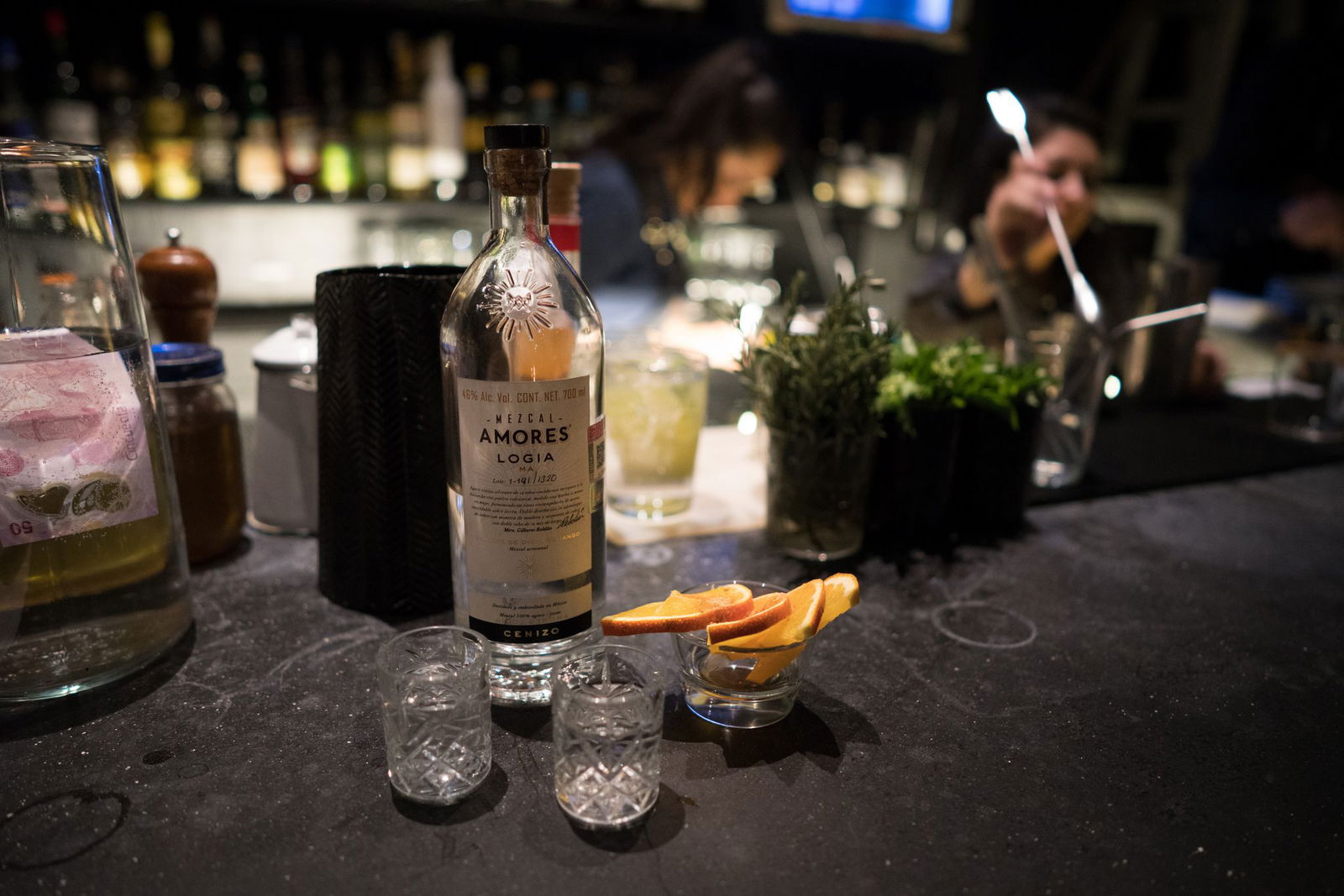
A bottle of artisanal mezcal. Image: Flickr / Nan Palmero
Ancestral Mezcal Ancestral mezcal is perhaps the most restrictive category dictated by NOM regulations, with mezcals only falling under this heading when their piñas are cooked in direct-fire pit ovens, hand crushed with stone or wooden mills, and fermented in animal hides, wood, or earthen and stone vats with the maguey fibers not filtered out. This type of mezcal must also be distilled in direct-fire clay stills with wooden or clay still tops. Seriously, this is a very particular category. JOVEN (WHITE) Joven or white mezcal is unaged and clear in color.
A bottle of joven mezcal. Image: Wikimedia / carlos.mezcal
REPOSADO Reposado tequila is aged for at least two months in either holm oak or white oak casks and tends to have a light caramel color. AÑEJO Añejo (sometimes referred to as Añejado) is aged for at least one year in similar casks to the reposado and tends to have a dark caramel color. MADURADO (MATURED IN GLASS) This type of mezcal is ancestral mezcal that's been allowed to mature in glass containers. DORADO (GOLDEN) Dorado mezcal is not aged, but is colored with an additive. MEZCAL DE GUSANO Mezcal de Gusano means "mezcal with worm." So yeah, if you want to suck down a wormy worm, grab yourself a bottle of Mezcal de Gusano.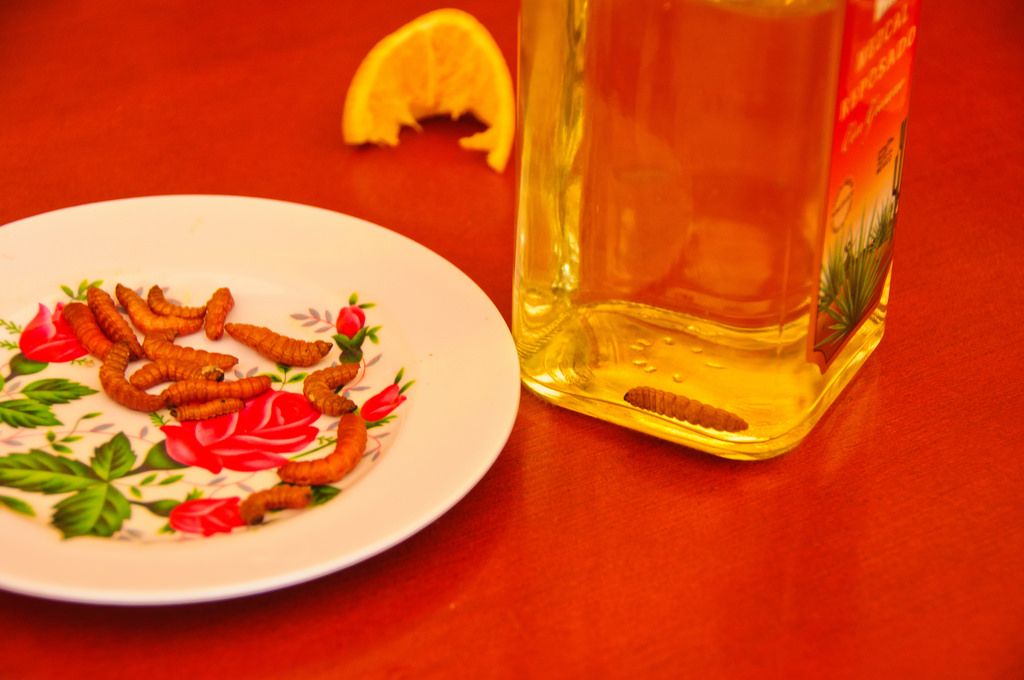
A bottle of mezcal de gusano with its signature worm in the bottom of the bottle. Image: Flickr / Graeme Churchard
DISTILADO CON (DISTILLED WITH) Distilado con is mezcal that has been re-distilled with grains, fruits, or even raw meats to add additional flavors. ABOCADO CON (FLAVORED WITH) Abocado con mezcals are those that have added flavors or essences of flavor, and also may have an added worm. SOTOL, BACANORA, AND RAICILLA Sotol, Bacanaro, Raicilla all designate specific plants from which a given mezcal has been made. Sotol is made from the "Desert Spoon" succulent, which isn't an agave plant, which means, yes, Sotol isn't even technically a mezcal. You still may see it pop up as a mezcal though. Bacanaro is made from the Agave angustifolia and is named after the eponymous town. Raicilla is made from Agave lechuguilla and is frequently associated with Puerta Vallarta, a city in Mexico. Sotol is made from the Dasylirion wheeleri, or Desert Spoon, and it is also known as the Sotol plant. NOM NUMBERS If you know all of the types and categories listed above, you're just about set in terms of understanding any mezcal labels you'll come across at the liquor store, market or bar. But there is one last thing you'll see on mezcal labels, and that's a NOM number. Why is that important? Because that will tell you that the mezcal you’re holding is an official mezcal from Mexico that's been produced at a genuine mezcal distillery. For example, you may see “NOM 1535” on a bottle of mezcal, which tells you that this particular bottle complies with NOM standards and was produced at the distillery associated with the number 1535. Keep in mind that the NOM number does not tell you where in Mexico the mezcal was produced, only which distillery produced it. You could still just look up where a given distillery is in Mexico once you have its name though, right?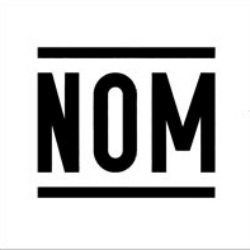
Picture of the NOM official logo. Image: Wikimedia / Tequila Regulatory Council
HOW TO DRINK MEZCAL
Once again people, we come to the fun part: how exactly should you drink this delicious, smoky stuff? We'll tell you how! And while these tips are in no way mandatory for enjoying mezcal, you'll still want to keep them in mind if you ever find yourself chilling by a fire with some mezcaleros or just trying to impress everybody at your local cantina. SIP IT NEAT (SERIOUSLY, SIP DON'T SHOOT) The first commandment of drinking mezcal is: thou shall not shoot. Thou shall only sip. Why is this the case? Well, imagine shooting a glass of whiskey you just bought for $25 — you'd never do it, right? It's the same case here with mezcal, which should, more or less, be drunk like whiskey. This means that you pour your mezcal into a copita — a cup that looks like a shallow clay dish — and go through all the same steps you would with whiskey. I.e. stick your nose near (not in!) that cup you have in your hand and first take in all the aromas. After taking in the aroma bouquet, you'll want to take a small sip and swish it around inside of your mouth; this will open up your palate and get your taste buds ready for all of the alcohol they're about to have. Once you've sniffed and swished your mezcal, it's time to start sipping it nice and slow. And remember that you should be drinking this stuff at room temperature! If you chill your mezcal that will dull its flavor. (That's something people shooting vodka do, for obvious reasons....) But sipping your mezcal from a copita at room temperature is only half the story with how to drink mezcal properly. To do this whole thing right, you're going to want to get your hands on some orange slices and a few other critical, edible components. SERVE IT WITH SNACKS, ORANGE SLICES, AND/OR WORM SALT Alright, now that you have your copita full of room-temperature mezcal, it's time to add slices of orange, grapefruit, or guava covered in worm salt as a garnish. What is worm salt? It's exactly what it sounds like. Sal de Gusano or worm salt, is a traditional Mexican condiment that's used for mezcal, tequila, as well as a few foods such as salsa. It's made out of dried and crushed up mezcal worms — either a gusano rojo ("red worm") or a chinicuil ("maguey worm"), which are both caterpillars of the Comadia redtenbacheri moth — rock salt, and chiles.
Gusanos de maguey. Wikimedia / Andy Sadler
In terms of how to actually eat the stuff with your mezcal, you'll want to sprinkle the worm salt on top of your orange/grapefruit/guava slice and take bites of the worm-salt covered fruit slice in between sips in order to refresh your palate. Aside from the fruit slices and worm salt, you'll also want to get your hands on snacks such as carrots, flatbread, or crunchy fried crickets to accompany your mezcal. (Get out of your comfort zones, people!) DRINKING MEZCAL IN COCKTAILS When it comes to drinking mezcal in cocktails, yeah, we won't lie, you can basically just sub it in for any traditional cocktail that calls for tequila — for example, it's great in a Margarita or Paloma. But it's not only a perfectly suitable substitute for tequila, it can also come off the bench and replace gin or scotch in cocktails that usually call for those liquors — for example, you can make a mezcal Negroni or a mezcal Martini. (Go for an aged, smokier mezcal when replacing whiskey.)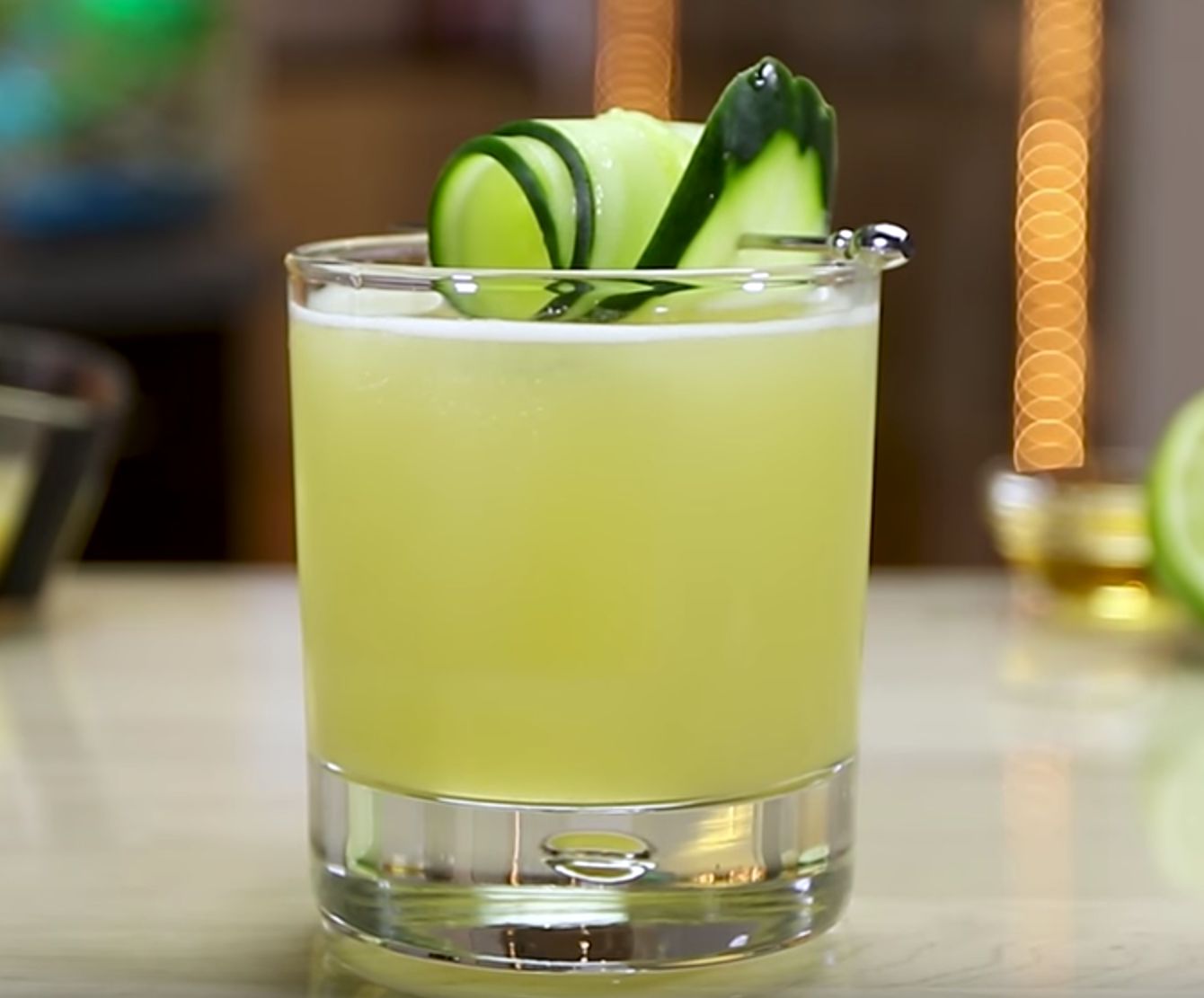
The mezcal mule. Image: Tipsy Bartender
Other than that, just have fun playing around with mezcal in cocktails. When it comes to a spirit that's as wide ranging in flavor profiles as mezcal is, the sky's the limit. Or you know, at least the top of the hot, earthen pit. AND FINALLY, THE WORM ITSELF OK, now we have to talk about... THE WORM! A.k.a. gusano de maguey. The gross thing that's usually associated with the bottom of a tequila bottle, but should be associated with the bottom of a mezcal bottle. Really, it's a mezcal thing so you may indeed see some genuine bottles of mezcal with a gusano de maguey in them. But even though you may rightly find a worm in your mezcal, as far as why it's actually in there in the first place is still kind of unclear.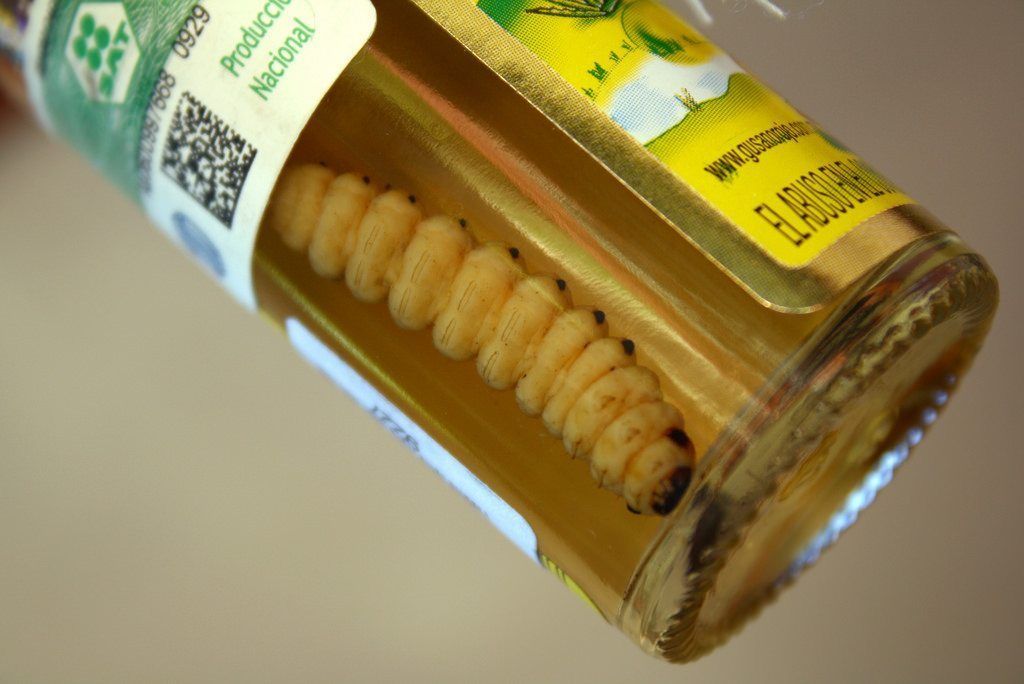
The worm in a bottle of mezcal. Image: Flickr / Rodrigo Tejeda
For example, Delish notes that one theory traces the origin of the mezcal worm "back to a distiller named Jacobo Lozano Páez, who in 1940 found that the larvae changed the taste of the agave and so began adding it to his spirits." Delish also notes that others attribute the mezcal worm to a test of potency — if the mezcal can pickle the worm, it must have a high percentage of alcohol, and therefore be good booze. VinePair adds that "There’s also the possibility this was purely a marketing angle, aimed at the American market. Tequila was flooding the U.S., and mezcal needed a way to differentiate itself. From here, ideas that the gusano indicated purity (a strong, pure mezcal would keep the worm intact) or could impart virility or good fortune were just a matter of some marketing imagination." Bottom line here: If you're talking about tequila, forget about the worm. If you're talking about mezcal, it may come in some bottles, but it's probably just a marketing ploy.HOW TO STORE MEZCAL
Here’s the really good news about storing mezcal: All you need to do to make sure its quality is kept intact is store it in a cool, dark place at room temperature, while also making sure that it’s securely sealed. Simple enough, right? In terms of specifics, all the rules are pretty common sense. Don’t store bottles of open mezcal (as some of their alcohol will evaporate), don’t store mezcal someplace warm, and don’t store it in a freezer.
The perfect light for storing mezcal bottles. Image: Flickr / Paul Sableman
Also, keep in mind that after you open a bottle of mezcal, it’s going to oxidize just like a bottle of wine. And while you don’t have to worry about mezcal the way you would about a bottle of wine, you’ll still want to make sure your bottle is kept shut tight after it’s open, otherwise it’ll start losing its flavor, usually within a month. And if you want to get real quirky with your mezcal storage, you can keep it in little wooden barrels like this one. Although mezcal in these tiny wooden casks may take on an extremely woody taste that could mask the mezcal’s natural flavor profile.THE FUTURE OF MEZCAL
The future of mezcal looks as bright as a clear blue Mexican sky. Although, as mentioned earlier, mezcal sales in the U.S. still pale in comparison to those of tequila, things still seem to be on the upswing. In a paper published in the Oxford University Press on the topic, titled Hipsters, Hope, and the Future of Artisanal Mezcal, author Sarah Bowen noted that "In the last few years, sales of artisanal mezcals have increased considerably, with mezcal bars popping up in cities in Mexico and in the United States." This sentiment is supported by other recently published articles, including this one by National Geographic titled "A Mezcal Boom Spurs Creative Approaches to Dwindling Agave," and this one by Anthony Bourdain's Parts Unknown titled "Can Mezcal Survive Being Popular?"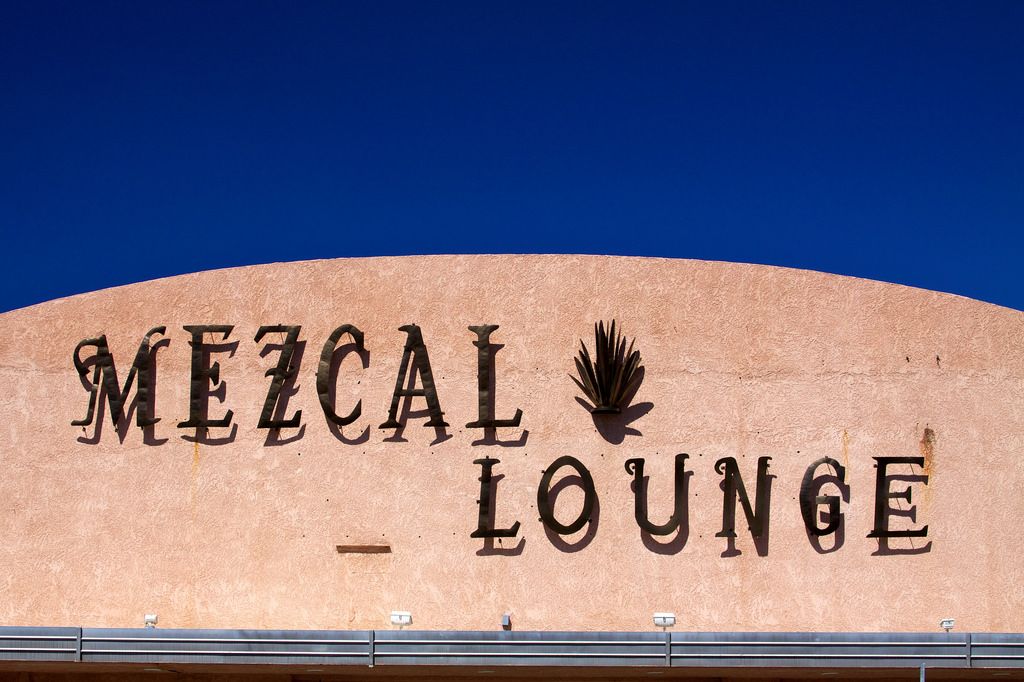
Expect to see a lot more mezcal bars and lounges. Image: Flickr / Chris Saulit
In terms of how exactly mezcal will become popular, it looks like it's going to do so as one of those elusive "popular yet niche" trends that catches on with people who are into that type of deal. This means that you should expect to see a rise in mezcal use accompanying a rise in the popularity of mixology. You'll also probably start seeing a lot more mezcal bars popping up near you depending on where you live in the U.S. (or in another country...). Regardless of how mezcal finds its way to becoming popular, it seems destined to happen in the coming years. Not only because it's a rich spirit with an endless range of flavors, but also because there's a good chance a blue agave shortage could mean a dwindling supply of tequila. And what better substitution for tequila than mezcal?NINE OF OUR FAVORITE MEZCAL DRINKS
1. BLOOD IN BLOOD OUT 2. MEZCAL MULE
2. MEZCAL MULE
 3. MEZCAL NEGRONI
3. MEZCAL NEGRONI
 4. ONCE UPON A TIME IN MEXICO
4. ONCE UPON A TIME IN MEXICO
 5. ROMEO & JULIET
5. ROMEO & JULIET
 6. SILENT SMOKE
6. SILENT SMOKE
 7. SLIGHT PINCH
7. SLIGHT PINCH
 8. SNAKES AND SPARKLERS
8. SNAKES AND SPARKLERS
 9. SOME BLACK SMOKE
9. SOME BLACK SMOKE

GIFS: Giphy

420 Drinks
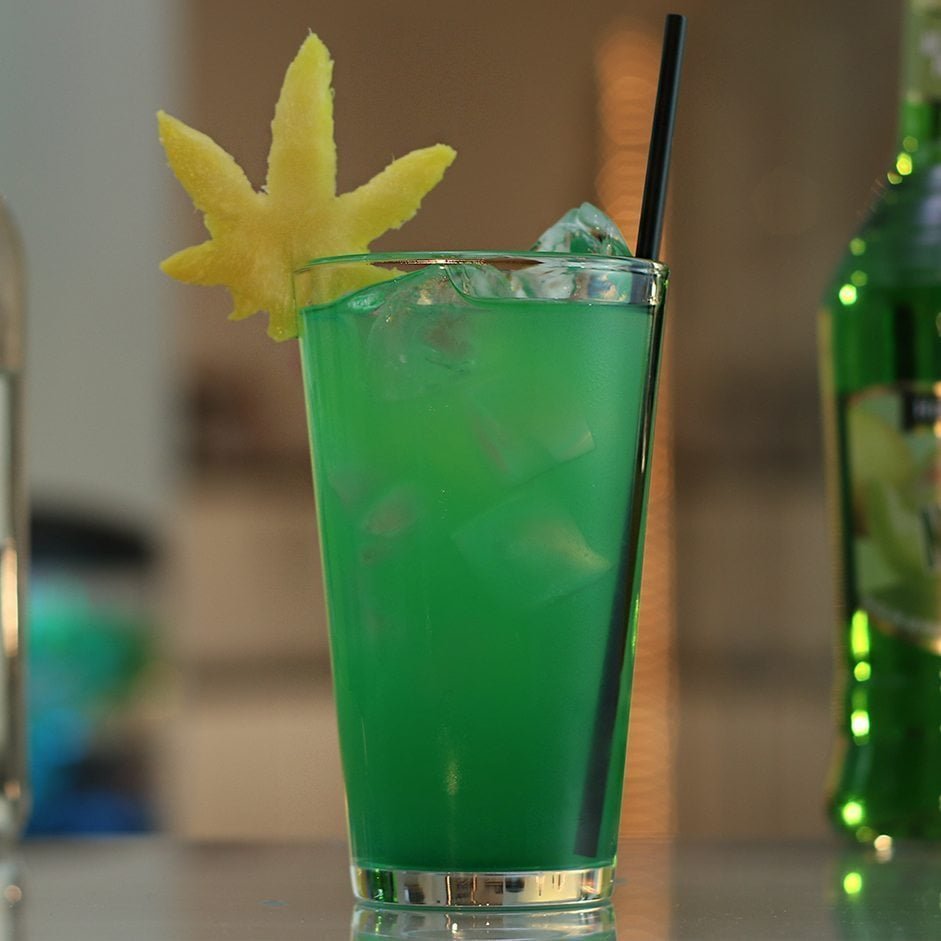
Liquid Marijuana Cocktail
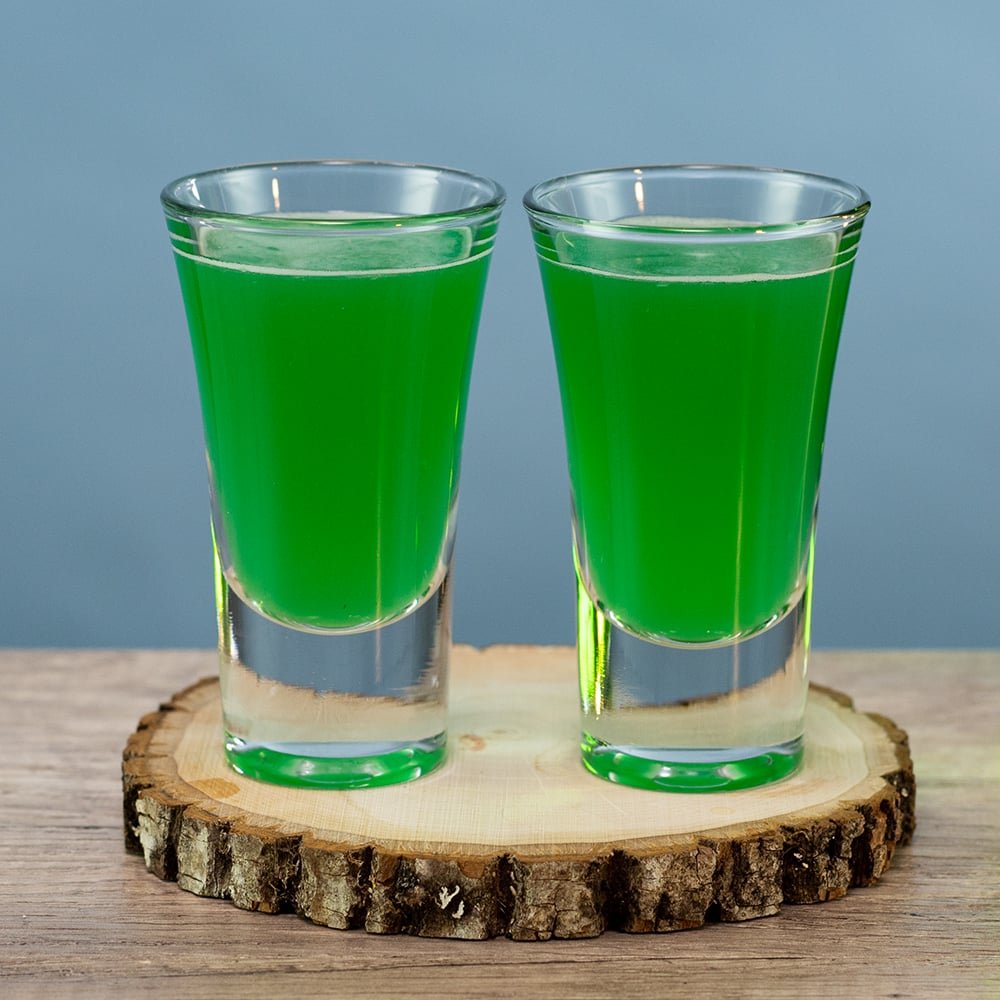
Liquid Marijuana Shot

Marijuana Jungle Juice Bowl
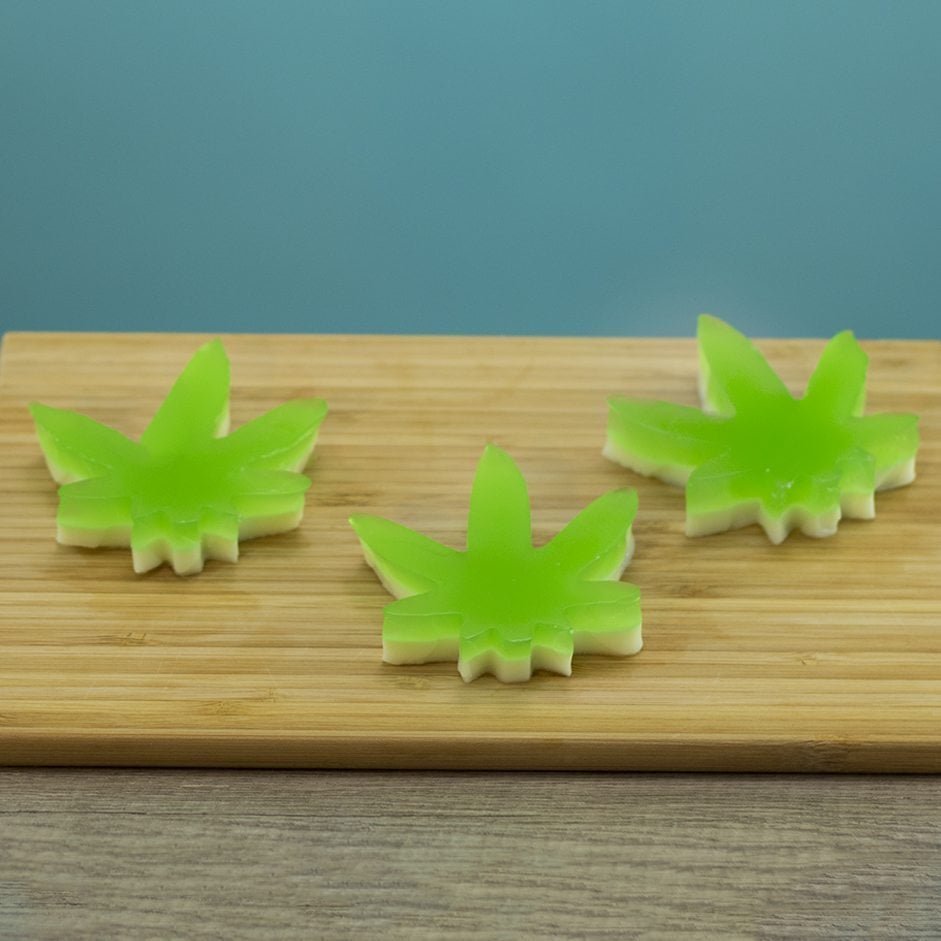
Marijuana Leaf Shaped Jello Shots
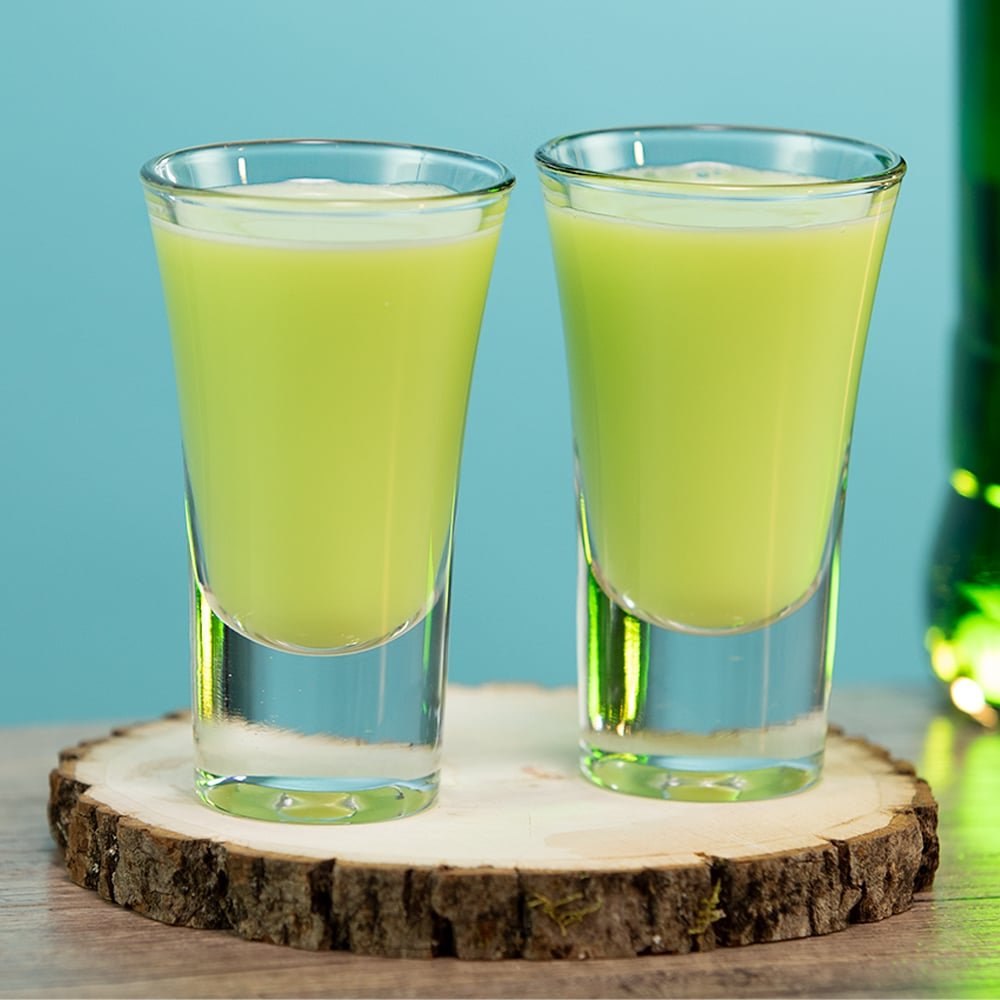
Marijuana Milkshake Shot
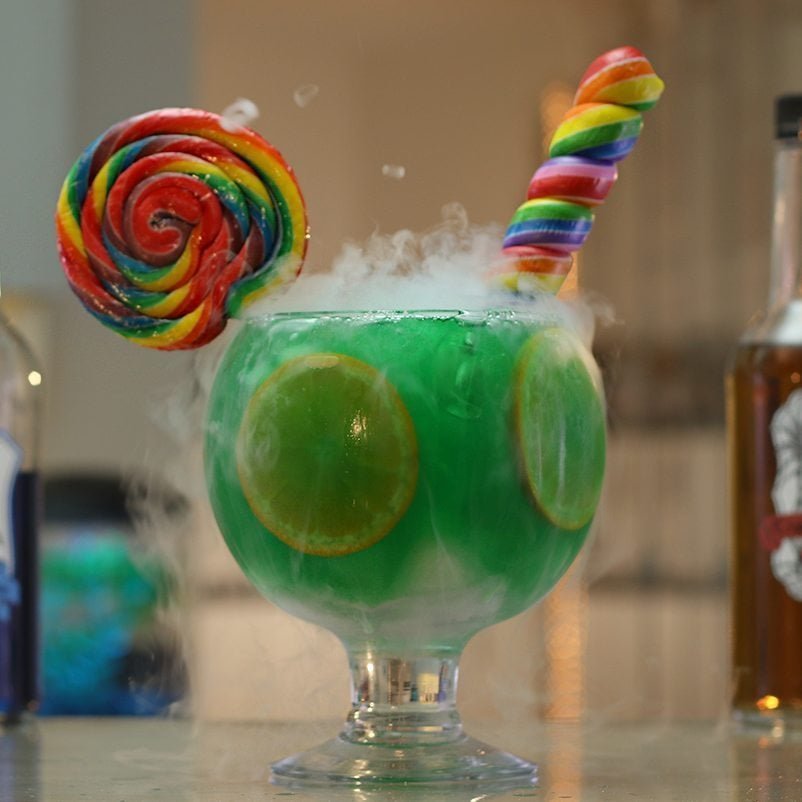
Sugar Marijuana Goblet
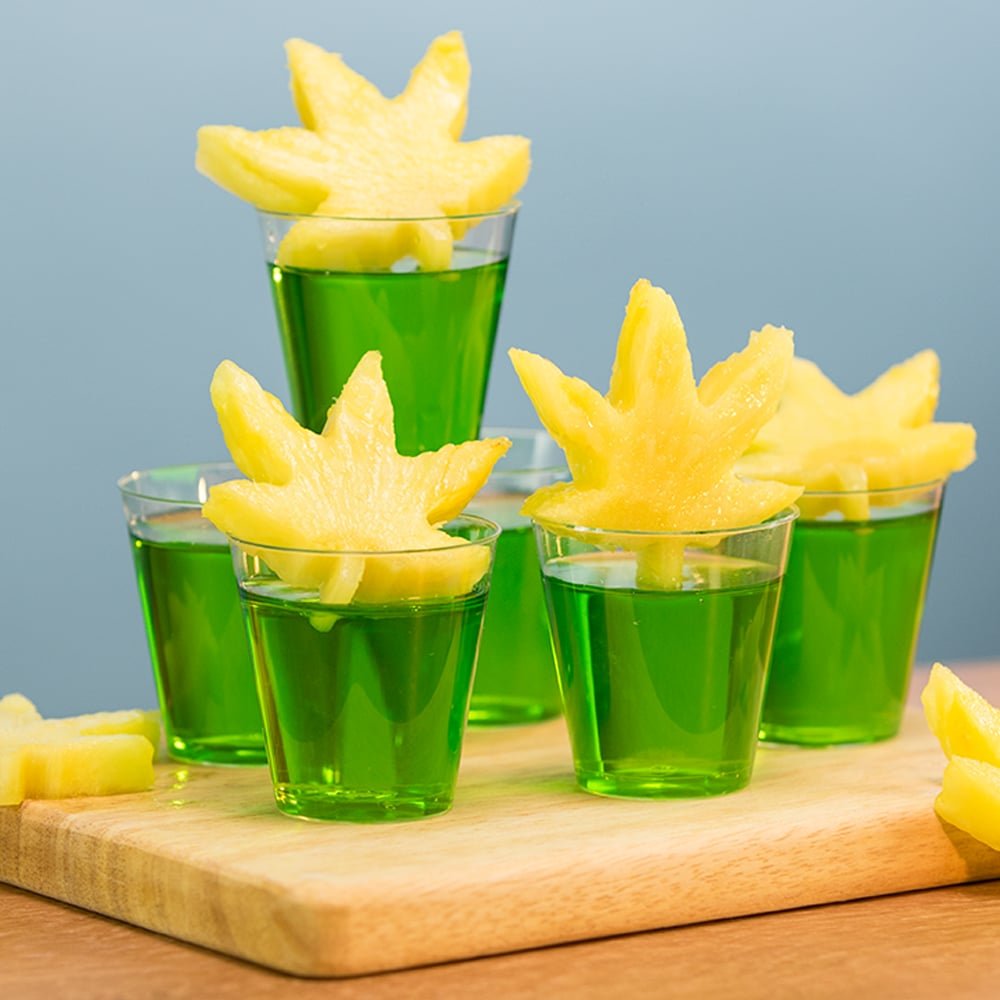
420 Liquid Marijuana Jello Shots
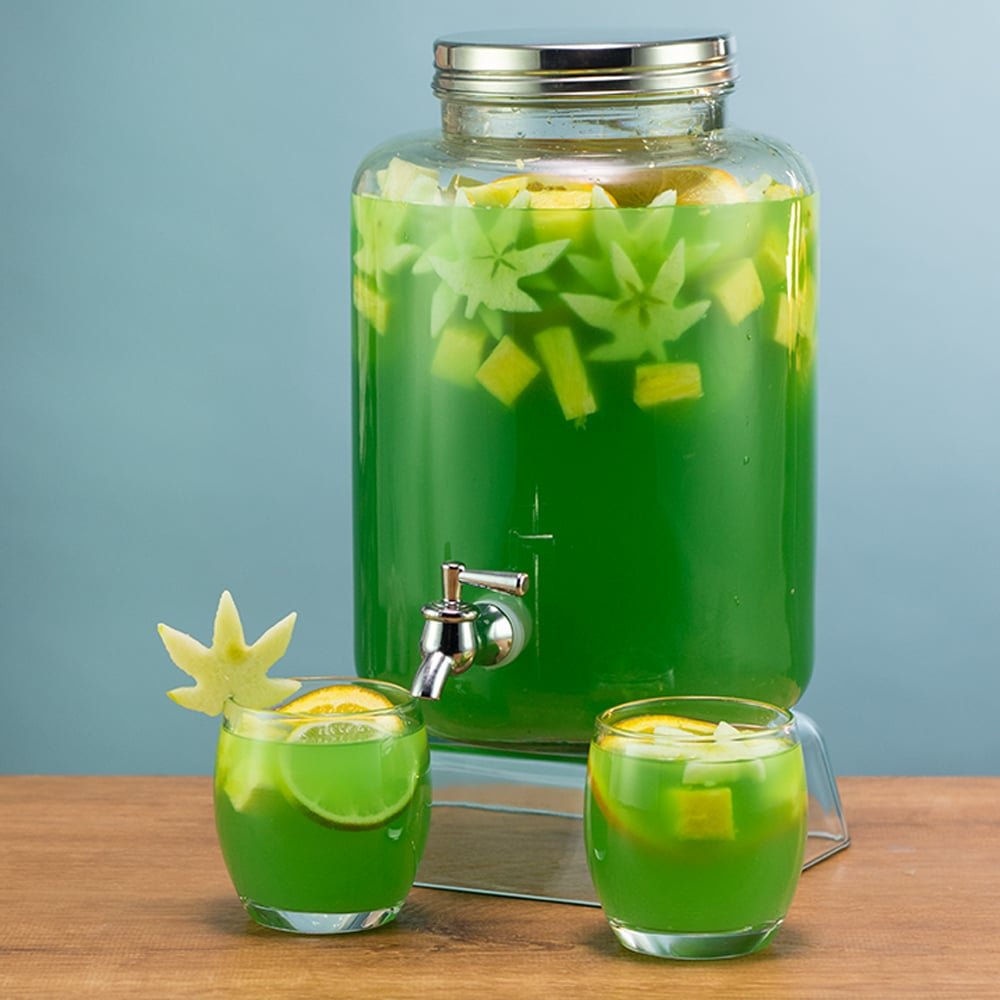
420 Liquid Marijuana Jungle Juice
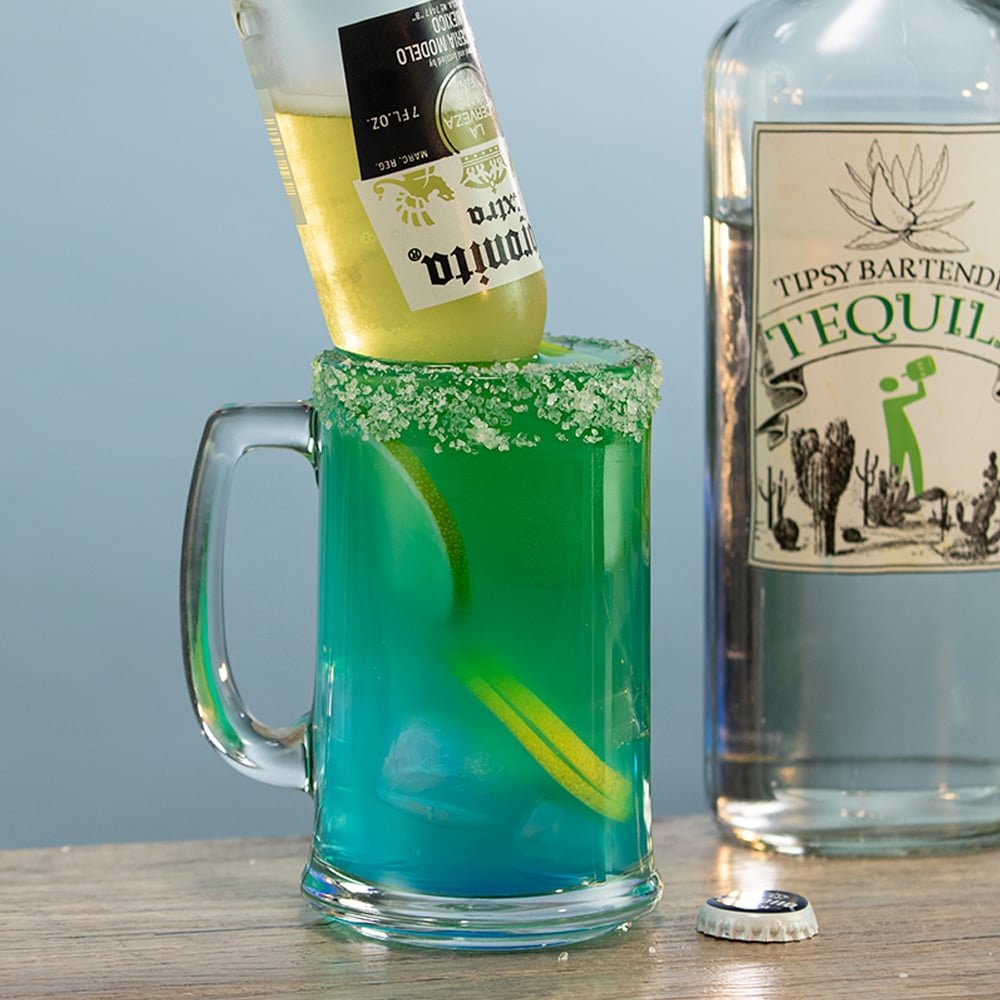
Mary Jane

Flaming Bob Marley Shot
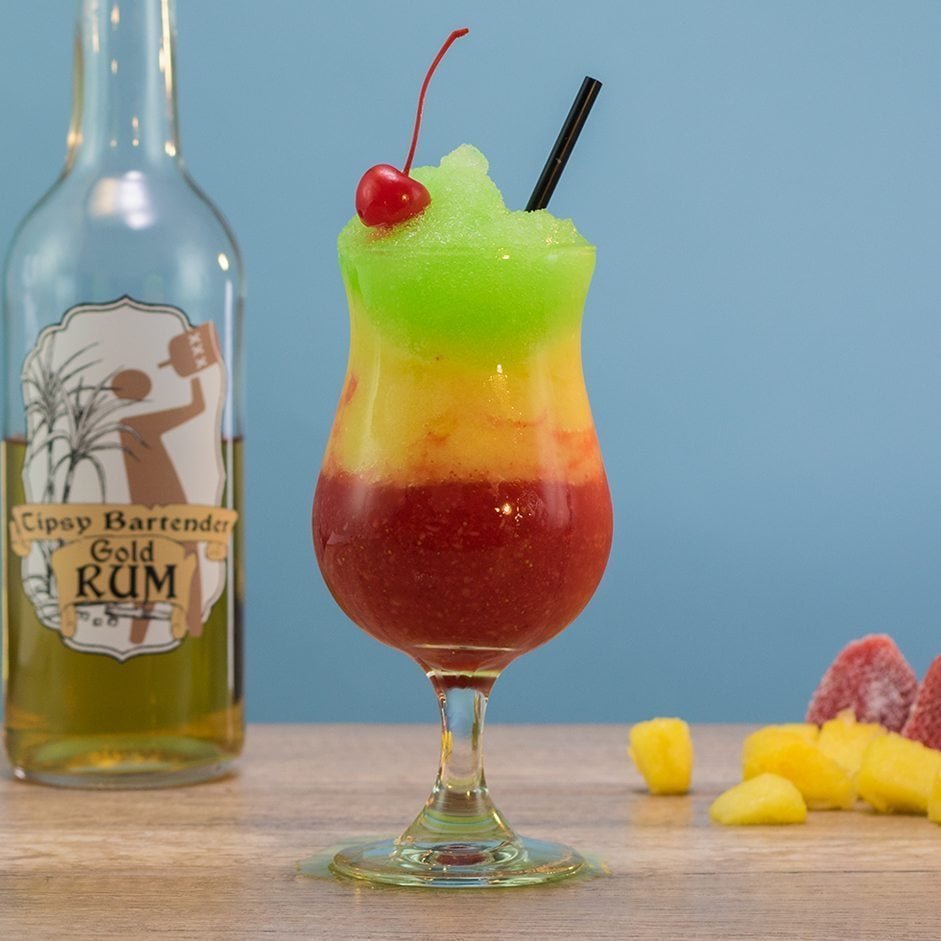
Twisted Bob Marley

Bob Marley Jello Shots













